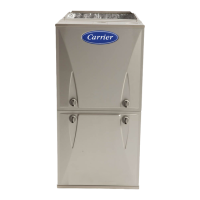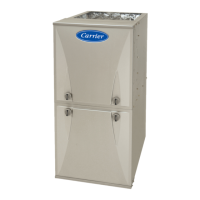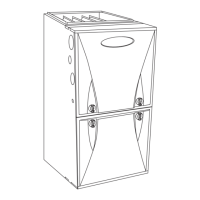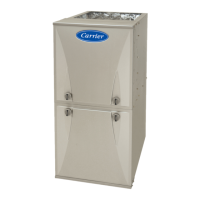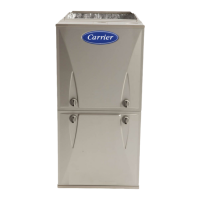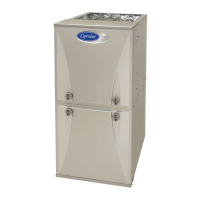48
4. Disassemble loose pipe fittings. Clean and cement using
same procedures as used for system piping. DO NOT CE-
MENT POLYPROPYLENE FITTINGS.
(Direct Vent / 2-Pipe System ONLY)
When two or more furnaces are vented near each other , two vent
terminations may be installed as shown in Fig. 53, but next vent
termination, or pair of vent terminations, must be at least 36 in.
(914 mm) away from the first two terminations. It is important that
vent terminations be made as shown in Fig. 53 to avoid
recirculation of vent gases.
Inducer Outlet Restrictor
To improve efficiency and operation of 40K, 60K, 100K or 120K
BTUH input models on very short vent systems, an inducer outlet
restrictor is required to be installed on the outlet of the inducer
assembly. The outlet restrictor is shown in the footnote of Table 16
-- Maximum Equivalent Vent Length. The outlet restrictor for 40K
models is shipped in the loose parts bag. See Table 16 for usage,
part numbers and sourcing of 60K, 100K, and 120K inducer outlet
restrictors.
To determine if the outlet restrictor is required, see Table 16.
Failure to use an outlet restrictor on the 40K input model when
required may result in flame disturbance or flame sense
lockout.
To install the outlet restrictor:
1. Remove the vent elbow from the inducer outlet.
2. Align the lock tabs on the outlet restrictor with the slots on
inside outlet of the inducer assembly.
3. Snap the outlet restrictor in place.
4. Re-install the vent elbow.
5. Torque vent elbow clamp 15-lb--in.
Table 14 – Approved Combustion-Air and Vent Pipe, Fitting and Cement Materials (U.S.A. Installa tions)
MATERIALS
USA
1. All pipe, fittings, primers*, and solvents* must conform to American National Standards Institute (ANSI) standards and
American Society for Testing and Materials (ASTM) standards or ULC S636 where required by code.
2. See Table below for approved materials for use in the U.S.A.
3. ULC S636 vent systems must be composed of pipe, fittings, cements, and primers from the same supplier.
4. Factory accessory concentric vent kits are ULC S636 listed.
CANADA
1. Installation in Canada must conform to the requirements of CAN/CSA B149 code.
2. Vent systems must be composed of pipe, fittings, cements, and primers from the same supplier and listed to ULC S636.
3. Not all materials below may be approved or listed to ULC S636.
4. Royal Pipe and IPEX are approved suppliers of ULC S636 pipe, fittings, cements and primers*.
5. Factory accessory concentric vent kits are ULC S636 listed for use with Royal Pipe and IPEX venting systems
Material Description
Type ASTM or ULC Specification
Pipe Solvents/Primers** Cements
PVC
Pressure Pipe Schedule 40 D1785
D2466
or
D2665
F656 D2564
DWV Schedule 40 D1785/D2665
Cellular Core Schedule 40 F891
SDR 26 N/A D2241
SDR 21 N/A D2241
IPEX Schedule 40 ULC S636 ULC S636 ULC S636 ULC S636
Royal Pipe Schedule 40 ULC S636 ULC S636 ULC S636 ULC S636
ABS
ABS Schedule 40 D1527 D2468
Clear Cleaner For ABS†
D2235
DWV--IPS Sizes Schedule 40 D2661 D2661
Cellular Core DWV--IPS Sizes Schedule 40 F628
CPVC
Pressure Pipe Schedule 40 F441 F438 F656 F493
SDR N/A F442 N/A
IPEX Schedule 40 ULC S636 ULC S636 ULC S636 ULC S636
Royal Pipe Schedule 40 ULC S636 ULC S636 ULC S636 ULC S636
*PVC and ABS pipe may use either DWV or pressure rated fittings.
**Colored or tinted solvents or primers must be used where required by code in the USA
†ABS plastic does not require a primer before solvent cementing. A cleaner for ABS is recommended to remove any surface residue. ABS
cleaners are not subject to ASTM standards.
Polypropylene Approved Manufacturer Solvents Primers Cements
Poly Pro® M & G Dura Vent Not Permitted
Not Permit-
ted
NOTE: Polypropylene vent systems are UL−1738 and ULC S636 listed and assembled using mechanical fastening systems
supplied by the vent manufacturer.
59SP2A
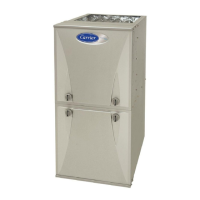
